
Bloomsbury is a district in the West End of London, part of the London Borough of Camden in England. It is considered a fashionable residential area, and is the location of numerous cultural, intellectual, and educational institutions. Bloomsbury is home of the British Museum, the largest museum in the United Kingdom, and several educational institutions, including University College London and a number of other colleges and institutes of the University of London as well as its central headquarters, the New College of the Humanities, the University of Law, the Royal Academy of Dramatic Art, the British Medical Association and many others. Bloomsbury is an intellectual and literary hub for London, as home of world-known Bloomsbury Publishing, publishers of the Harry Potter series, and namesake of the Bloomsbury Group, a group of British intellectuals which included author Virginia Woolf, biographer Lytton Strachey, and economist John Maynard Keynes.

Baker Street is a street in the Marylebone district of the City of Westminster in London. It is named after builder William Baker, who laid out the street in the 18th century. The area was originally high class residential, but now is mainly occupied by commercial premises.
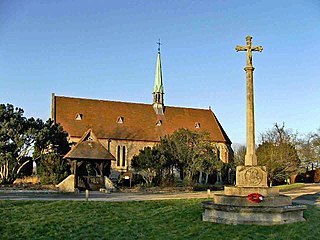
Bayford is a village and civil parish in the East Hertfordshire district of Hertfordshire, England. According to the 2001 census it had a population of 435, increasing to 466 at the 2011 Census. The village is about three miles south of Hertford, and is served by Bayford railway station.

The Portman Estate, covering 110 acres of Marylebone in London’s West End, was founded in 1532 when the land was first leased to Sir William Portman.
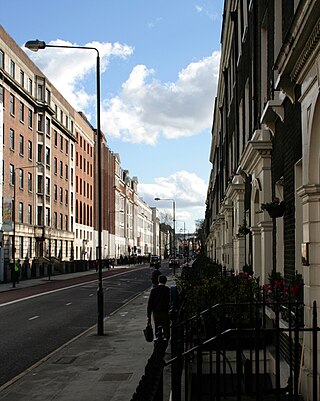
Gower Street is a two-way street in Bloomsbury, central London, running from Euston Road at the north to Montague Place in the south. The street continues as North Gower Street north of Euston Road, while to the south it becomes Bloomsbury Street.

Cavendish Square is a public garden square in Marylebone in the West End of London. It has a double-helix underground commercial car park. Its northern road forms ends of four streets: of Wigmore Street that runs to Portman Square in the much larger Portman Estate to the west; of Harley Street which runs an alike distance; of Chandos Street which runs for one block and; of Cavendish Place which runs the same. The south side itself is modern: the rear façade and accesses to a flagship department store and office block. On the ground floors facing are Comptoir Libanais, Royal Bank of Scotland and Pret a Manger premises.

Dorset Square is a garden square in Marylebone, London. All buildings fronting it are terraced houses and listed, in the mainstream (initial) category. It takes up the site of Lord's (MCC's) Old Cricket Ground, which lasted 23 years until the 1811 season. Internally it spans 100,000 square feet (9,290 m2).
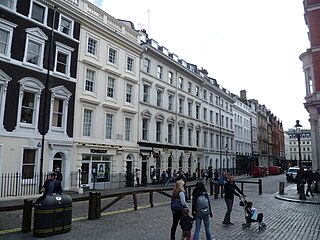
Henrietta Street is a street in Covent Garden, London, that was once home to a number of artists and later became the location of many publishing firms.

Percy Street is a street in the London Borough of Camden that runs from Rathbone Street in the west to Tottenham Court Road in the east. At its western end it is joined by Rathbone Place and Charlotte Street. Nearby Percy Mews is off Rathbone Place. The street was built in the 1760s and is known for the number of artists that have lived there.

Chenies Street is a street in Bloomsbury, London, that runs between Tottenham Court Road and Gower Street. It is the location of a number of notable buildings such as Minerva House, the Drill Hall, and a memorial to The Rangers, 12th County of London Regiment. North Crescent starts and ends on the northern side of Chenies Street.
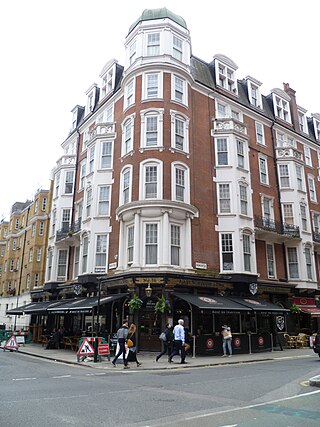
Huntley Street is a street in Bloomsbury, London, known for its close association with University College Hospital.

Ridgmount Street is a street in Bloomsbury, London.
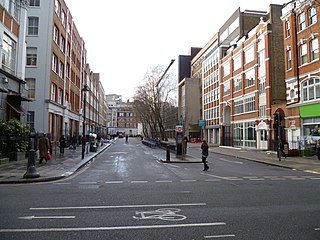
Alfred Place is a street in Bloomsbury, London, running between Chenies Street and Store Street.

Torrington Place is a street in London that runs between Tottenham Court Road in the West and Byng Place in the East. It is crossed by Huntley Street and Gower Street. Chenies Mews joins it on the north side and is continued by Ridgmount Gardens on the south side.

Store Street is a street in Bloomsbury, London.

Mount Street is an east–west, quite narrow, archetypal street in the Mayfair district of the City of Westminster, London fronted by many mid-rise buildings, mostly of a narrow frontage. The sides of two very grand hotels flank part of either end of the street. Small, high-end property businesses, investment funds and accountancy businesses punctuate the buildings as well as a row of traditional businesses and conversion-style mansion block apartments or, more generally, authentic such homes.

Luxborough Street, formerly Northumberland Street, is a street in the City of Westminster, London, that runs from Marylebone Road in the north to Paddington Street in the south. Nottingham Street joins Luxborough Street on its eastern side.

Hyde Park Square is a residential, tree-planted, garden square one block north of Hyde Park fronted by classical buildings, many of which are listed and marks a crossover of Lancaster Gate and Connaught Village neighbourhoods of Bayswater, London. It measures (internally) 200 by 500 feet, of which the bulk is the private communal garden – the rest is street-lit, pavemented streets with low railings in front of the houses. Connaught Street runs eastwards from the square towards the Edgware Road.

Orsett Terrace, originally known as Orsett Place, is a street in the Westbourne district of the City of Westminster, in London. It runs roughly east–west between Porchester Terrace in the west and the junction of Westbourne Bridge and Westbourne Terrace in the east. It is crossed midway by Gloucester Terrace.
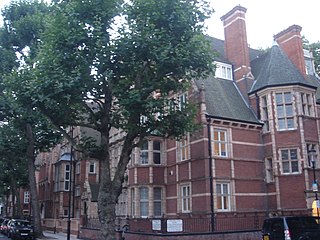
Collingham Gardens is a garden square in the Royal Borough of Kensington and Chelsea in London. Built between 1881 and 1888, the buildings on either side of the garden were designed by Ernest George and Peto, a firm that grafted Northern European urban motifs onto plainer Queen Anne style stock.




















